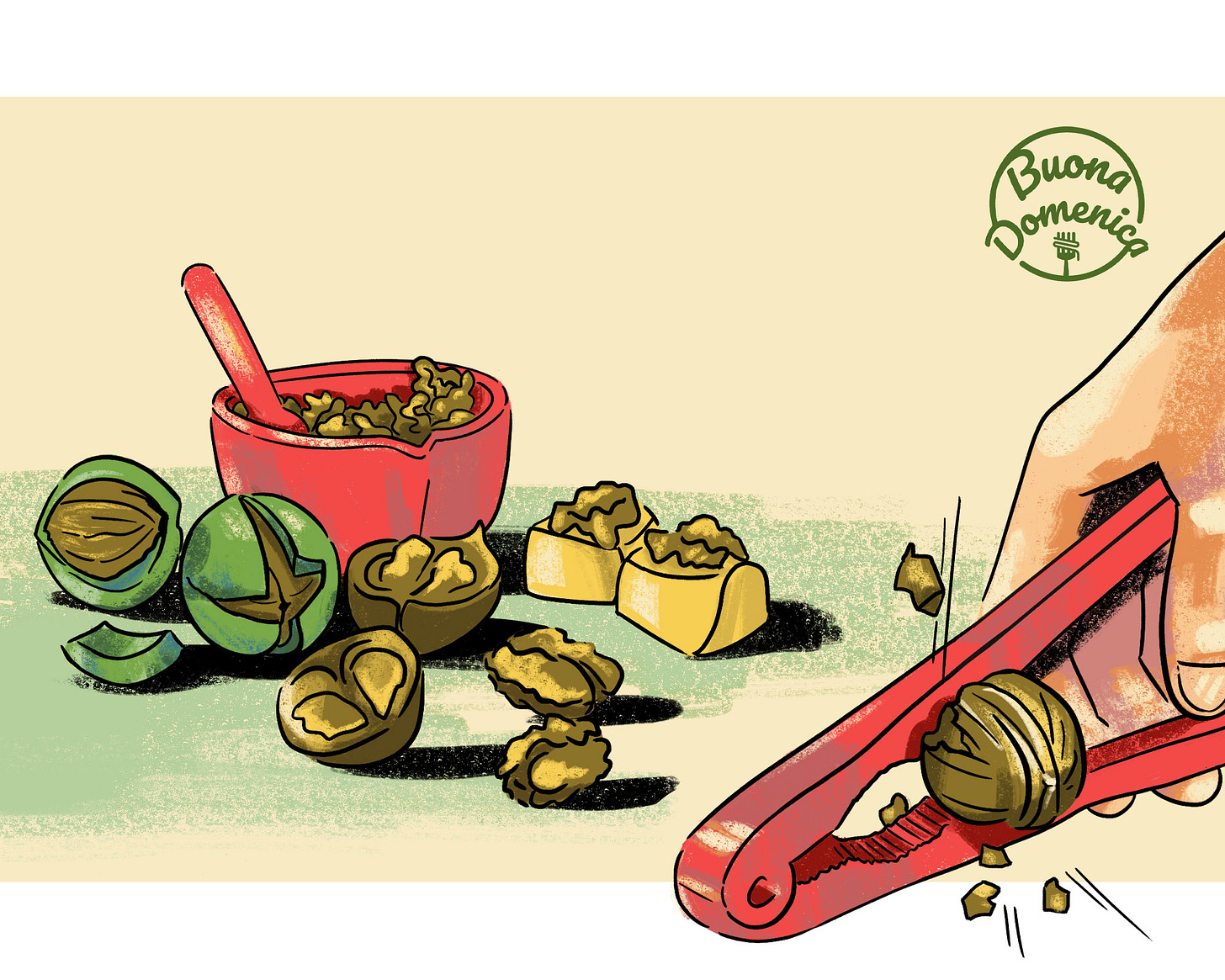
There’s an ongoing dispute in my family between those who adore raw walnuts (me) and those who are wrong (everyone else). Over the years, my son has likened eating walnuts to “eating wood furniture,” “eating wax,” and “eating waxed wood furniture.” My husband and daughter are less vocal, but that pretty much sums up their attitudes as well.
And yet, when walnuts are ground up and added to other ingredients, they (my family, and maybe walnuts, too) sing a different tune. My husband’s favorite Christmas cookies are the delicate, crumbly Linzer hearts from The Silver Palate Cookbook, the recipe for which calls for 2 cups finely grated walnuts (plus lots of butter). Our son regularly makes white pesto with ground walnuts and ricotta as an alternative to classic Genovese pesto. And the other night, our daughter told me that the tagliatelle con le noci that I made for dinner last Sunday (recipe below) “is one of my all-time favorites of your pastas.” (I wrote an entire book of pasta recipes, so that’s saying something.)
My own fondness for walnuts (in any form) dates to long ago Christmases, when our mother would sit my sister and me down at the kitchen table with bags of whole nuts—walnuts, hazelnuts, and almonds—and two nutcrackers. It was our task to shell the nuts, which would then be employed in the making of buttery crescent cookies (hazelnuts) and nut- and honey-filled calcionelli (almonds and walnuts). You’d think I would forever despise all nuts after that tedious chore, but my memories of those nut-cracking sessions are nothing but happy. I enjoyed the challenge of trying to extract the two crimped halves intact (not easy)—even if, ultimately, it didn’t matter because they were going to be chopped up. Once the required amount of nuts were shelled, any extras were put in a bowl and kept on the table along with the nutcrackers and, nearby, a packet of dried figs. Walnut-stuffed figs are still one of my favorite winter snacks. You should try them: snip off the tip of a soft dried fig, pry it open and fill it with walnut pieces. Close it back up and take a bite.
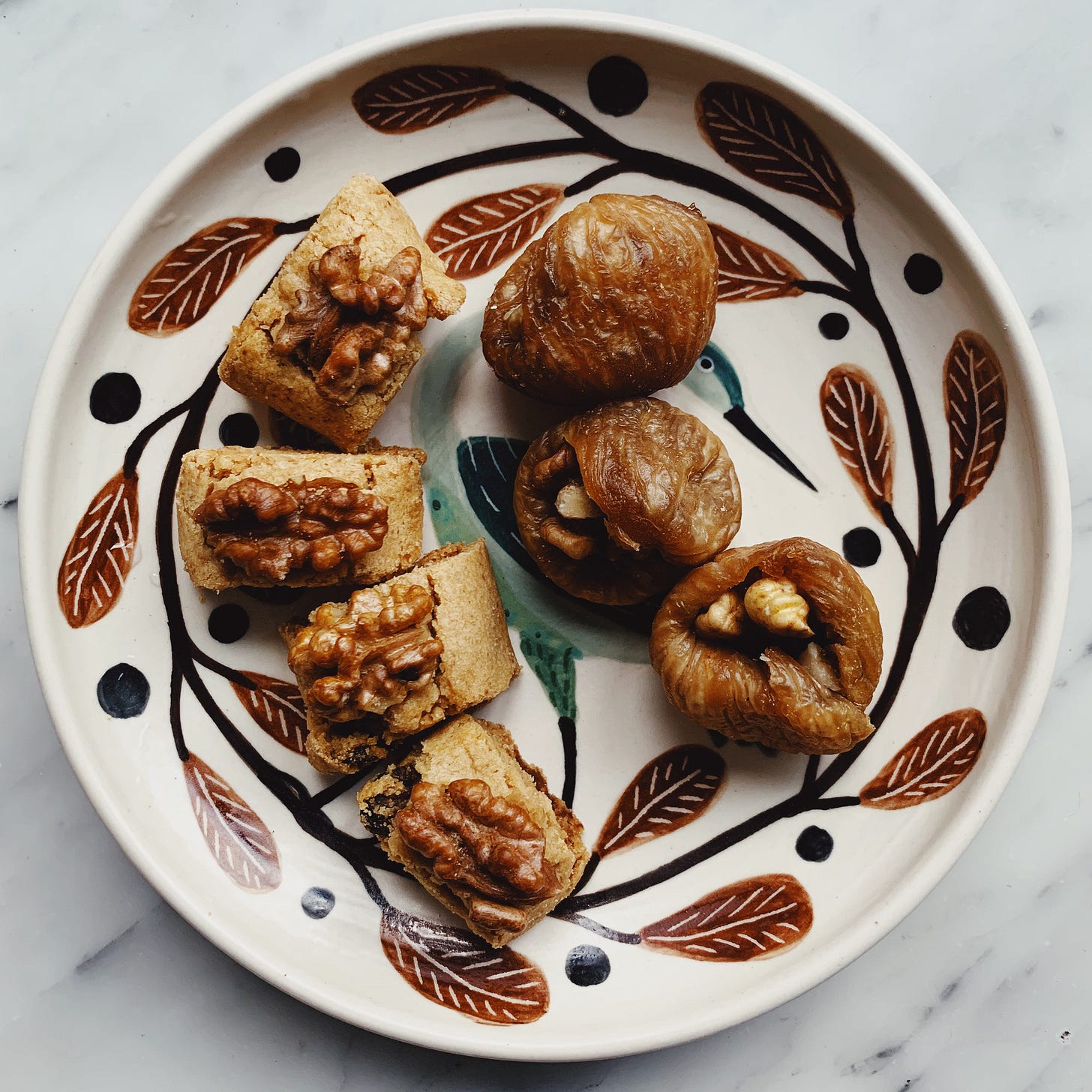
Italians call nuts “frutta secca” (dried fruit), and that’s exactly what they are: dried, single-seed fruits with a hard shell and protective husk. Walnuts are considered a seasonal treat in Italy; harvested in fall, dried for a few weeks, and then sold at markets throughout winter and into spring, until the supply is depleted. The little alimentari in Penne (Abruzzo), where I stayed for a few weeks last fall, sold them, still in the shell, by weight; the shopkeeper kept a large sack, presumably from his own tree, near the entrance, with a scoop for helping yourself.
Walnuts are perishable and keep best in their shell; once shelled, they can quickly go rancid due to the high amount omega-3 fatty acids they contain. (We’ve all had the displeasure of biting into a rancid piece of walnut in a Waldorf salad or inside a brownie.) But don’t mistake rancidness for bitterness, which to me is one of the nut’s virtues. That mild bite of astringency comes from the tannins in the nut’s thin skin, and it’s one of the reasons walnuts pair so well with ingredients like blue cheese, butter, and chocolate—those tannins cut right through the richness.
Young (green) walnuts are their own special delicacy, preserved in syrup or turned into marmalade. They are also the star ingredient in nocino, the inky, pleasantly bitter liqueur. Making nocino, by the way, is a fascinating process. You start by harvesting the nuts in June, while they are still unripe (the traditional date is June 24). At this point, the outer husk and shell are still soft enough to cut through, and the meat inside is pale and partially liquid. The nuts are quartered and steeped in alcohol (or alcohol and wine), spices, and sugar for 40 or more days. The mixture turns murky almost immediately, as the nuts start to oxidize soon after being cut open (always wear kitchen gloves when cutting open young walnuts). Once steeped and filtered, set your bottled nocino away to cure for several months; it improves as it ages and keeps for several years. (You can find a full recipe for nocino in my book Preserving Italy: Canning, Curing, Infusing, and Bottling Italian Flavors and Traditions. )
I’m sure this post sounds like it’s sponsored by the Walnut Council (there is one; I just googled it), but it’s not. A generous friend recently sent me a care package of walnuts from her home state of Oregon, and that is what set my gears turning. (She sent hazelnuts, too, but that’s a subject for another day).
As I was thinking about which recipes to share in this week’s post, it occurred to me that walnuts are featured in many Eastern European recipes. I have a handful of cookbooks on Eastern European cuisine, including Anya von Bremzen and John Welshman’s Please to the Table, and Ukrainian food writer Olia Hercules’s marvelous Mamushka. Sure enough, in the pages of Olia’s book, I found a recipe for buttery Ukrainian walnut biscotti. So, in addition to the aforementioned tagliatelle con i noci and in a gesture of solidarity with the Ukrainian people, I’m sharing Olia’s recipe for walnut biscotti, along with a list of organizations that are providing aid and support to Ukraine.
RECIPE: Tagliatelle con le Noci
There’s a little magic in this pasta that looks—and even tastes—a bit like tagliatelle alla Bolognese, one of Italy’s most iconic dishes. Like Bolognese, the walnut-based sauce is luxurious, with plenty of fat and only a hint of tomato. You might think it was a modern, vegetarian take on the classic, with nuts standing in for rich beef and pork. But I found the recipe in my mother’s much used and much loved, now rather fragile copy of Ada Boni’s Il Talismano della Felicità, which is at least six decades old and probably closer to seven. There’s not much fanfare to the recipe—a simple list of ingredients and four sentences of instructions. But it caught my eye and I’m glad it did, for while true Bolognese takes hours to make, this sauce comes together in the time it takes to boil your pasta water. (I’ve translated and fleshed out the recipe a bit.)
If a special Sunday dinner is your goal, you may want to go all out and make homemade tagliatelle all’uovo (egg tagliatelle); the sauce is worthy! However, dinner will be just as enjoyable if you use good-quality packaged pasta.
The original recipe calls for “salsa densa di pomodoro” or “dense” tomato sauce. With no further explanation provided, I chose to interpret this as simple (homemade) tomato sauce that had been cooked down to become more concentrated. If you don’t have sauce on hand, you can substitute a lesser amount of good quality-tomato paste with similar results.
Makes 4 servings
INGREDIENTS
1 cup (120 g) shelled walnuts
2 tablespoons extra-virgin olive oil
4 tablespoons dense (cooked down) tomato sauce; or 2-3 tablespoons tomato paste
6 tablespoons (90 g) butter
Fine salt and freshly ground black pepper
1 pound (454 g) fresh tagliatelle all’uovo or packaged tagliatelle or fettuccine
Freshly grated Parmigiano-Reggiano cheese
INSTRUCTIONS
Bring a large pot of water to boil and salt it generously.
While the water is heating, make the sauce. Pound the walnuts in a mortar until crushed to fine bits; there may be some inconsistency in their size but that’s what you want for this sauce. Just be sure to stop before the oils from the nuts start to release or you’ll end up with paste. If you don’t have a mortar and pestle (why??), blitz the nuts in a food processor fitted with the metal blade until most are finely ground. Scoop them into a bowl.
Pour the olive oil into a large, heavy-bottomed skillet and add the walnuts. Turn the heat onto medium-low and cook, stirring often, for about 5 minutes, until you can smell the nuts beginning to toast. Stir in the sauce and butter and cook, stirring, until the butter is melted and the sauce starts to bubble lightly. Season with a pinch of salt and several grindings of pepper. Turn off the heat and cover the pan to keep the sauce warm.
Cook the pasta until just al dente (fresh pasta will cook in under 5 minutes; follow the manufacturer instructions for packaged pasta). During the last minute or so of cooking, ladle some of the pasta water into the sauce and stir. Drain the pasta, reserving a little more of the pasta water. Transfer the noodles to the skillet and toss gently with the sauce. Stir in some Parmigiano cheese (the amount is up to you but don’t be skimpy) and add another splash of pasta water if necessary to loosen the sauce. Serve with more cheese for sprinkling on top.
RECIPE: Ukrainian Biscotti
“These cookies are beyond moreish…” writes Olia Hercule in the head note to her recipe for these bite-sized twice-baked cookies. And she’s right; it’s hard to stop at just one. With both butter and ground nuts in the batter they are richer than traditional biscotti. They go well with coffee or tea, not to mention a glass of nocino after dinner. Olia says you can substitute pecans or pistachios for the walnuts. Recipe from Mamushka, a Cookbook: Recipes from Ukraine & Eastern Europe, by Olia Hercules.
Makes about 40 biscotti
INGREDIENTS
5 ounces (150 g) walnut halves
1 egg yolk
1/4 cup (60 g) superfine sugar
5 tablespoons (75 g) unsalted butter
1 tablespoon rum (optional)
Pinch of fine sea salt
1/3 cup (60 g) golden raisins or dried apricots, chopped
1 cup (130 g) unbleached all-purpose flour, plus more for dusting
1/2 tablespoon milk, to glaze
INSTRUCTIONS
Line a baking sheet with parchment. Blitz half the nuts in a food processor until finely ground. Cut the rest in half lengthwise and set aside.
Mix the egg yolk, sugar, butter, rum (if using), ground nuts, and salt together in a bowl, then mix in the dried fruit and flour. Knead the mixture briefly—you should end up with a soft dough.
Flour your work surface lightly. Divide the dough into 4 equal pieces and roll each piece into a log about 1 inch (2.5 cm) in diameter. Flatten the tops slightly, then brush with milk. Arrange the reserved nuts vertically, side by side (like little soldiers,) along the tops of each log. Push the nuts down every so slightly to make sure they don’t fall off. Carefully transfer the logs to the baking sheet, then chill in the refrigerator for 30 to 60 minutes.
Heat the oven to 350° F (180° C). Bake the logs for 15 minutes, then remove them from the oven and carefully slice each log into 10 pieces. Lower the oven temperature to 300° F (150° C) and bake the biscotti for a further 30 minutes, then switch the oven off and leave the biscotti inside to dry and cool. They will become crispy as they cool (but not hard), buttery and nutty.
#CookforUkraine
Inspired by the #CookforUkraine movement started by Ukrainian and Russian food creatives Olia Hercules and Alissa Timoshkina, a group of Instagram food friends and I will be gathering together on Zoom next Sunday (March 13) to host a cooking class to raise funds for Ukraine. We posted about it last night on our accounts, and by this morning when I woke up it was sold out (we capped it at 60). Our goal was to raise €1000 and I’m happy to say we raised more than twice that amount. Funds are going to a number of organizations (we asked class attendees to make a donation of at least €10 to a reputable charity currently providing financial/humanitarian aid to Uktraine and to screen shot their receipts).
Because of the overwhelming response, we may be organizing more such classes. If you are interested, please leave a comment here and I will put you on a notify list. You can also find out more on my Instagram page.
There are many worthy organizations that are providing support to Ukraine. Two that I have donated to are Chef Jose Andres’ charity, World Central Kitchen, which has been feeding tens of thousands of refugees on the border of Ukraine since the invasion; and the Kyiv Independent, a fledgling news operation that is in Ukraine reporting on the war. The publication was started by former reporters from the Kyiv Post after that newspaper’s oligarch owner temporarily shut down operations and fired staff late last year.
MORE ORGANIZATIONS
Here’s a link to a list of groups to support compiled by the Washington Post. And one compiled by the Obama Foundation.
PICTURE ITALY: Penne (Abruzzo), Fall 2021
As always, thank you for reading, sharing, and subscribing.
Alla prossima,
Domenica




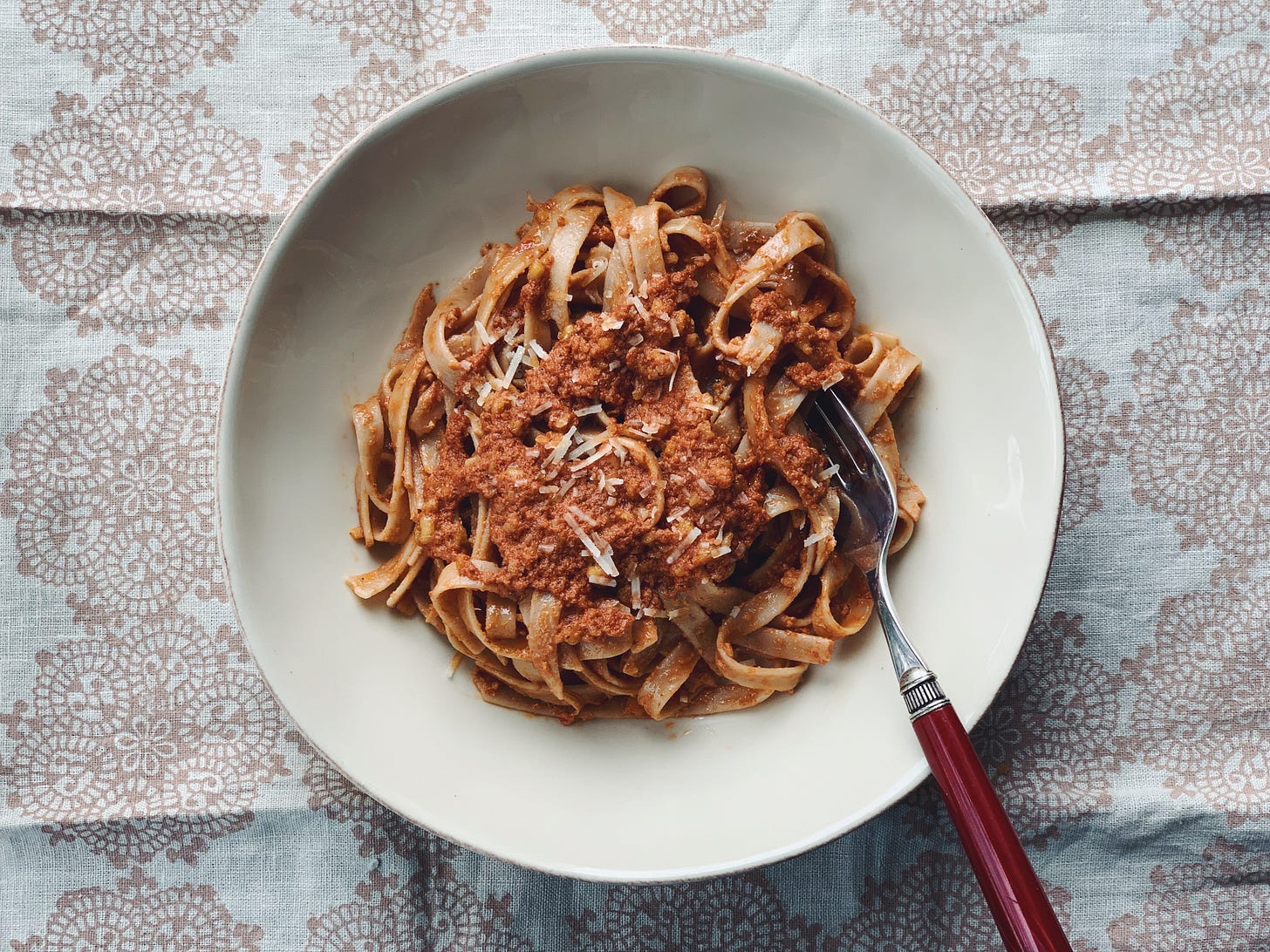
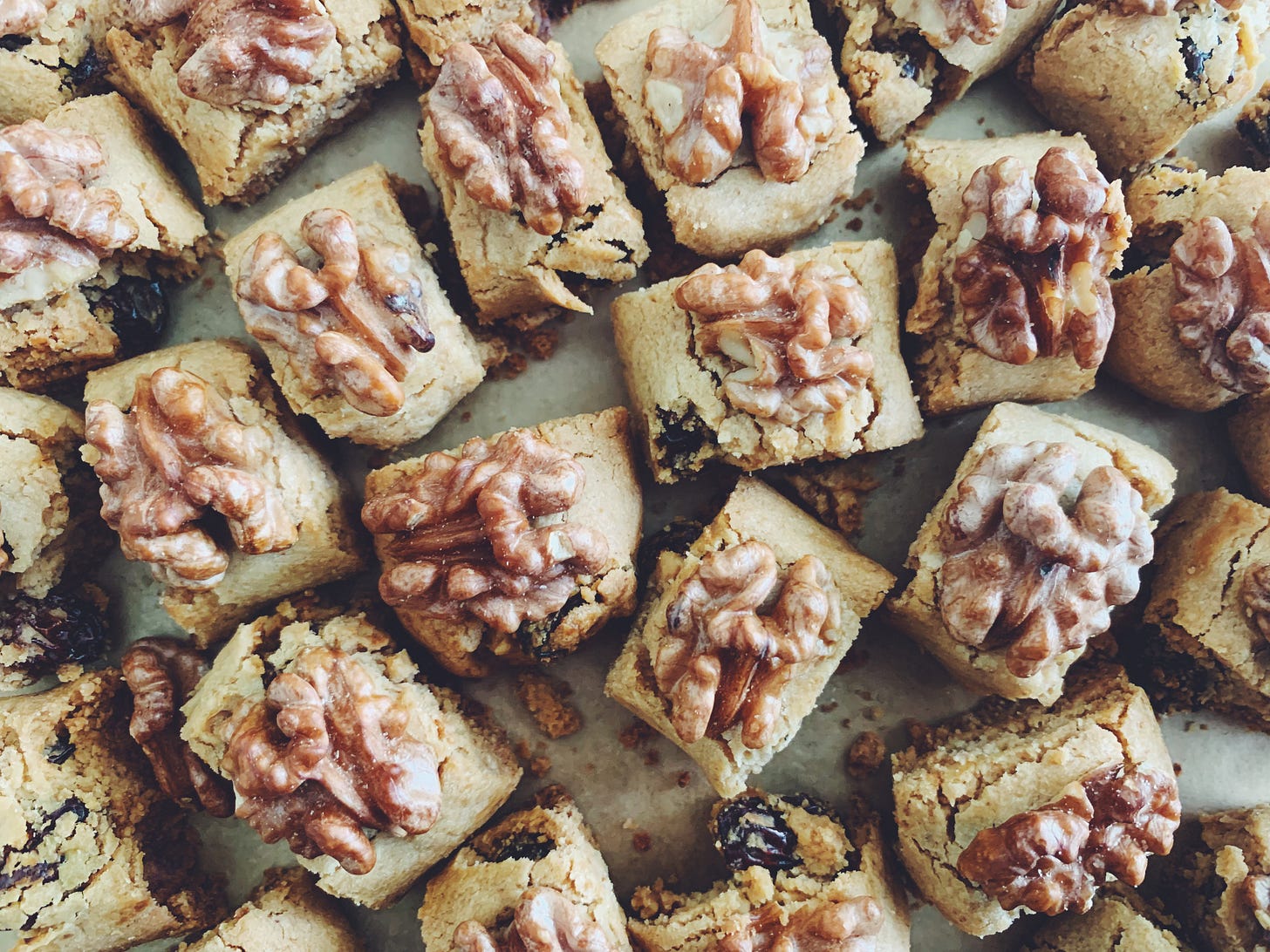
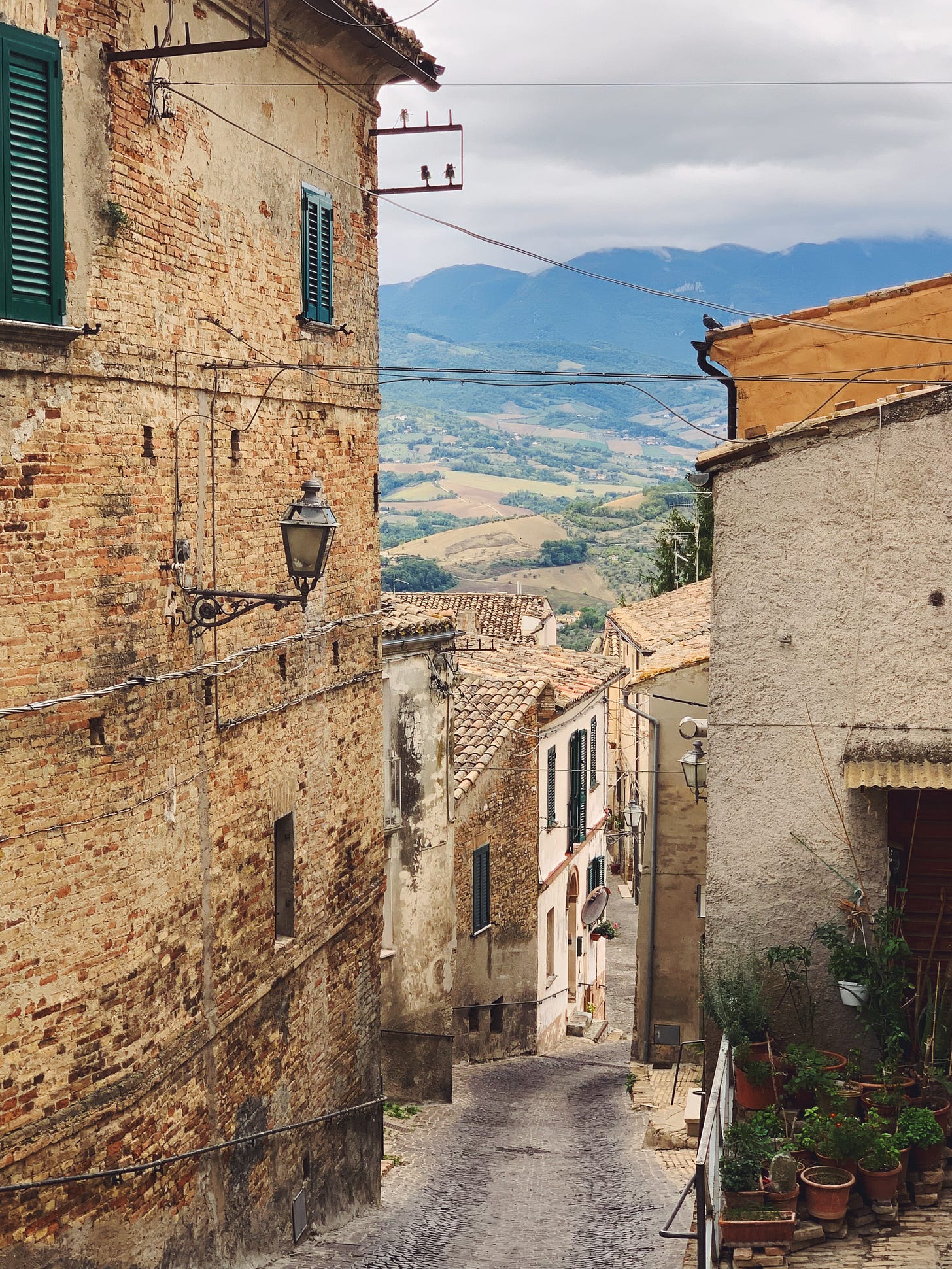
Cara Domenica,
First, blessings for your cooperative efforts in supporting the Ukrainian people. So much suffering and sorrow for them.💔
Second, your memories of walnut “ picking” as myself and my siblings called it. I was a child in the 1950s and it was common to crack the shells and pick the meat out carefully. We even had a nut cracker set with picks for that! My mother put us to work each Christmas or holiday before she started baking. We used and preferred walnuts to other nuts. My Nonna’s traditional nut roll, cookies, fudge, salads, etc. I still prefer them. The pasta recipe looks amazing! I love the stuffed fig idea but I have to check the sugar content these days. I can make it for the family however!
Many thanks for another great newsletter. I love how you break the ingredients down to the most tasty, and your techniques to the least complex. You give me such confidence!
Un grande abbraccio!
Please include me in any future classes for Ukraine. Great idea! Barbara Wilson